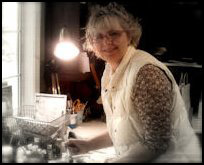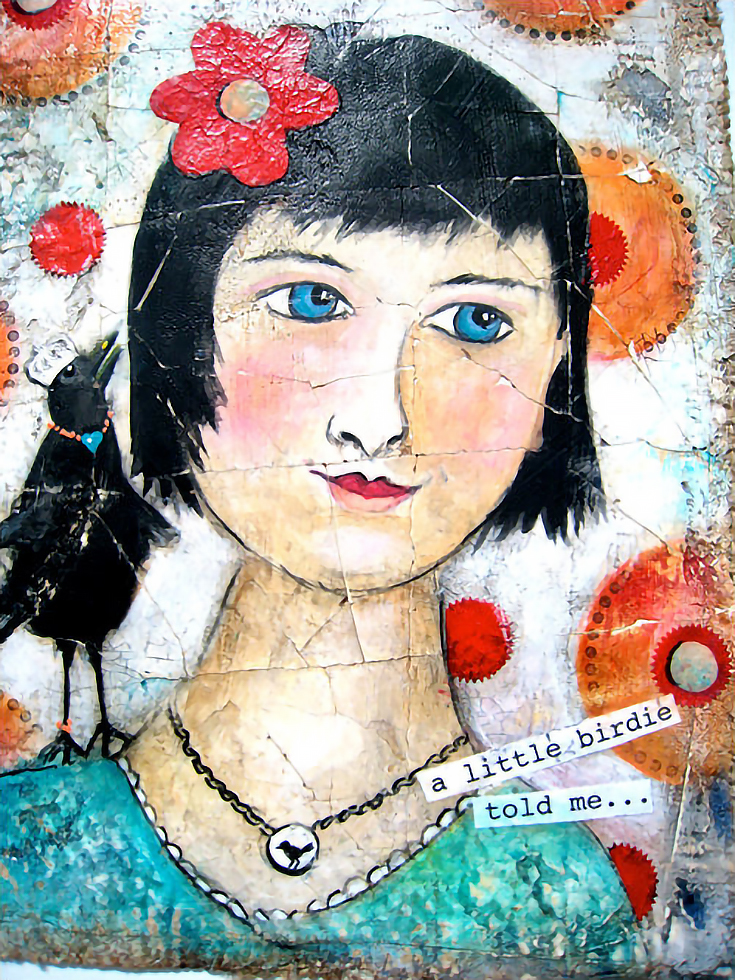
Today, with a BA in Studio Art from Scripps College, she teaches children to explore all the possible ways they can create through an after-school art program, is published in several arts magazines (like Somerset Studio), and runs an online art store on Etsy.
Alyice: Why did you choose mixed media as your medium?
Pamela: In college I was a sculpture major and also loved weaving. I painted in acrylic, but felt stumped if just given paint. I need texture. To me that is what makes a piece sing.
I started by making transfers of magazine photos and adding found objects to my work. Currently, I “need” to add paper, stamps, and stencils, as well as plaster and joint compound. . . the more stuff added, the better.
Alyice: What is the most challenging part about working with acrylics?
Pamela: I think acrylics can be boring. There is no texture to them. They don’t shine and are not transparent like oils so they need to be manipulated to give the desired effect.
The mixed media world is an incredible group of artists who are willing to share techniques. There are countless ways to learn about acrylics and all the different applications to make acrylics into your own media and the look the way you want.
Acrylics can be versatile and layered in thin glazes like oils or built up for texture. They are quick to dry, which means I can paint over a part I don’t particularly like rather quickly.
They are inexpensive and permanent. I have paintings outside made with small cheap craft paints that have still retained their color 10 years later. And finally, they are relatively safe.
I love the encaustic look, but do not want to deal with the safety issues so acrylics—with added friends—are my go-to medium.
Alyice: Do you do anything in particular to seal your art?
Pamela: I always paint a coat of acrylic gloss medium and varnish over my art to give the piece a little sheen and to protect it.
I would be careful putting a painting in direct sunlight, but I do have pieces that have been in the yard for years and the colors are still bright.
Alyice: What is your creative process like?
Pamela: I have a very haphazard schedule—only paint when the muse strikes. I may go weeks without picking up a brush, and I do so try to be more consistent.
That is always on my New Year’s list. But with that being said, I am constantly thinking of ideas and sketching them out; I will never run out. Some days, I wish I could turn that part of my brain off.
I have really enjoyed sketching my ideas first on the iPad and I have volumes of journals filled with notes. I usually have at least 5 paintings going at one time and I rotate between them. At present I am preparing for an art exhibit in October and there are about 15 pieces strewn across the studio waiting my attention.
Alyice: How has your style changed over the years?
Pamela: As I said before, I used to paint with acrylics only and that did not resonate with me. I tried landscapes—not me. But as I added other forms of texture my style changed.
I have continually held a passion for still life art pieces. I love a beautiful picture of vases or bowls—empty or filled—with flowers. I don’t know why really. I think they just quiet my soul.
I also have a current obsession with crows, corgis and santos; a very unlikely combination, but there you have it.
I have always been creative, but in all honesty I painted very little while raising my kids. My energy went elsewhere. I never expected life would be so difficult (and joyous) at times and it is only recently—since my kids are raised—that I have returned to this love.
Being creative is simply using one’s God-given gift in whatever form it appears. I don’t honestly see craft as different from art. Writing a well-crafted blog post is just as fulfilling to me as painting. That gift we are given has to come out somewhere. Hopefully I will get better at drawing women. That is my area I am constantly battling with.
Alyice: What do you believe is a key element in creating a good composition?
Pamela: Oh that is a good question.
Basically I want my piece to stop the viewer in his tracks, to bring out a chuckle or a glint of the eyes. I want it to engage the viewer and enrich their few moments together so that the viewer’s response to the world grows just a little bit. So the composition can change and take whatever form it needs to bring about the end result.
Alyice: Aside from creating, and selling your original art, you teach an after-school art program. How did the program get started?
Pamela: I used to teach chapel art to a group of 8 students each year and we would make plays and banners for our weekly chapel time. I adored working with a small group, so I approached our school with the idea of teaching mixed media after school. . . right at the time the school happened to be wanting to expand their after school program.
Alyice: What have been the rewards of working with these children, from a personal standpoint, as well as one from that of the child?
Pamela: I love working with these kids. They are clever and think outside the box. They keep me young, although sometimes I may feel a little older after a lively session. They constantly challenge me and have made me a better person for which I have truly been blessed.
I know the kids love the class; I can see it in their eyes and smiles. I feel so honored to watch them bloom, to see their curiosity emerge, their confidence grow, and their love of different art media blossom. Our class has had two projects published in magazines and now they think they are famous.
Next year we are adding iPad art, since that is my newest obsession. What fun it will be to teach them to “paint” with their fingers on a tablet!
Alyice: What tips can you offer other artists who would like to start an after-school art program in their area?
Pamela: Go to the various schools in your area to see what they already have in place, and find out if there is a niche only you can fill with your particular gift.
Our school was hoping to add more after-school technology classes so I asked about doing iPad art and they were thrilled. It was a perfect fit. You never know until you try!
You can go the other route and promote your own class taught at your home, or rented space, but then you need to do all promotion, collect money, attendance, etc. So it just depends what you want to spend your time doing.
To learn more about Pamela and her art, visit pamelaholderman.blogspot.com.
This post may contain affiliate links.



